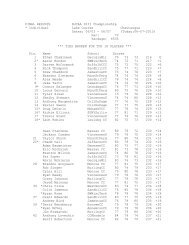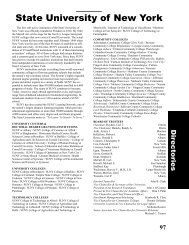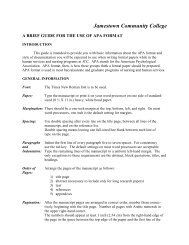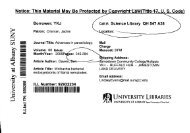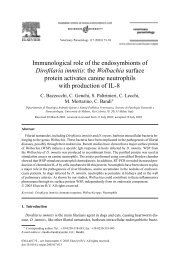Discrimination between six species of canine microfilariae by a ...
Discrimination between six species of canine microfilariae by a ...
Discrimination between six species of canine microfilariae by a ...
You also want an ePaper? Increase the reach of your titles
YUMPU automatically turns print PDFs into web optimized ePapers that Google loves.
Analyzer (Applied Biosystems, Foster City, CA) using<br />
universal M13 forward and reverse primers. Sequence<br />
results were compared with those <strong>of</strong> other <strong>species</strong><br />
within the Genbank data bank at the National Center<br />
for Biomedical Information.<br />
Additionally, we examined DNA quality <strong>by</strong><br />
performing PCR for <strong>canine</strong> actin on each sample,<br />
to ensure sufficient template for the micr<strong>of</strong>ilarial<br />
PCR.<br />
2.5. Micr<strong>of</strong>ilarial phenotyping<br />
In addition to the PCR genotyping, we performed a<br />
modified Knott’s test and wet smear on the blood<br />
submitted from Cases 1–3 and the positive control<br />
samples. The morphological diagnosis for the <strong>six</strong><br />
clinical cases is the preliminary morphological<br />
diagnosis provided with initial sample submission<br />
and not the diagnosis obtained <strong>by</strong> one <strong>of</strong> the authors<br />
(MFF).<br />
3. Results<br />
All blood-derived DNA samples were positive for<br />
<strong>canine</strong> actin (not shown), indicating adequate DNA<br />
extraction.<br />
Primers specific for D. immitis (D.imm-F1 and<br />
D.imm-R1), A. reconditum (A.rec-F1 and A.rec-R1)<br />
and D. repens (D.rep-F1 and D.rep-R1) amplified the<br />
expected products only from D. immitis (302 bp), A.<br />
reconditum (348 bp) and D. repens (247 bp, 153 bp)<br />
DNA, respectively (Fig. 1). The doublet amplicon<br />
obtained with primers specific for D. repens has been<br />
previously reported (Favia et al., 2000). There was<br />
marginal amplification <strong>of</strong> a product from A. reconditum<br />
DNA (247 bp) with D. repens-specific primers.<br />
No filariae-specific primer pairs amplified any<br />
products from DNA <strong>of</strong> the normal dog (negative<br />
control), or from DNA extracted from B. pahangi,<br />
B. malayi or A. dracunculoides (data not shown).<br />
These results confirmed the genotyping <strong>of</strong> D. immitis,<br />
A. reconditum and D. repens for subsequent analysis<br />
and the specificity <strong>of</strong> the primer sets.<br />
The pan-filarial primer pair (DIDR-F1 and DIDR-<br />
R1) amplified the expected product from D. immitis<br />
DNA (542 bp), and A. reconditum DNA (578 bp)<br />
(Fig. 2). Unexpectedly, this primer pair also amplified<br />
M. Rishniw et al. / Veterinary Parasitology 135 (2006) 303–314 307<br />
Fig. 1. Gel electrophoresis <strong>of</strong> filarial PCR products in a 1.5%<br />
agarose gel using filarial-specific ITS2-region primers. Lanes 1,<br />
6, 11, 16: MW marker (KB Plus); lanes 2, 7, 12: D. immitis DNA;<br />
lanes 3, 8, 13: A. reconditum DNA; lanes 4, 9, 14: D. repens (Case 1)<br />
DNA; lanes 5, 10, 15: C. familiaris DNA (negative control). Lanes<br />
2–5: D.immF1/D.immR1 primer pair; lanes 7–10: A.recF1/A.recR1<br />
primer pair; lanes 12–15: D.repF1/D.repR1 primer pair.<br />
a 484 base-pair product from the DNA extracted from<br />
Case 1 (D. repens-infested dog). The different sizes <strong>of</strong><br />
the amplicons for all three filarial <strong>species</strong> allowed us to<br />
use this pan-filarial primer set to genotype the filarial<br />
<strong>species</strong> in Cases 2–6.<br />
Filaria-specific primers for COI demonstrated<br />
specificity for each <strong>of</strong> the filarial <strong>species</strong> (Fig. 3),<br />
further confirming the genotyping <strong>of</strong> micr<strong>of</strong>ilariae<br />
from Case 1 as D. repens and validating the panfilarial<br />
primer set results.<br />
Results <strong>of</strong> PCR with pan-filarial primers from<br />
Cases 2–4 and 6 identified the micr<strong>of</strong>ilariae as D.<br />
immitis (Fig. 4) (confirmed with <strong>species</strong>-specific COI<br />
PCR); PCR from Case 5 identified the micr<strong>of</strong>ilariae as<br />
A. reconditum (also confirmed with <strong>species</strong>-specific<br />
COI PCR).<br />
Fig. 2. Gel electrophoresis <strong>of</strong> filarial PCR products in a 1.5%<br />
agarose gel using pan-filarial ITS2-region primers. Lanes 1, 4:<br />
MW marker (KB Plus); lane 2: A. reconditum DNA; lane 3: D.<br />
immitis DNA; lane 3: D. repens (Case 1) DNA.




